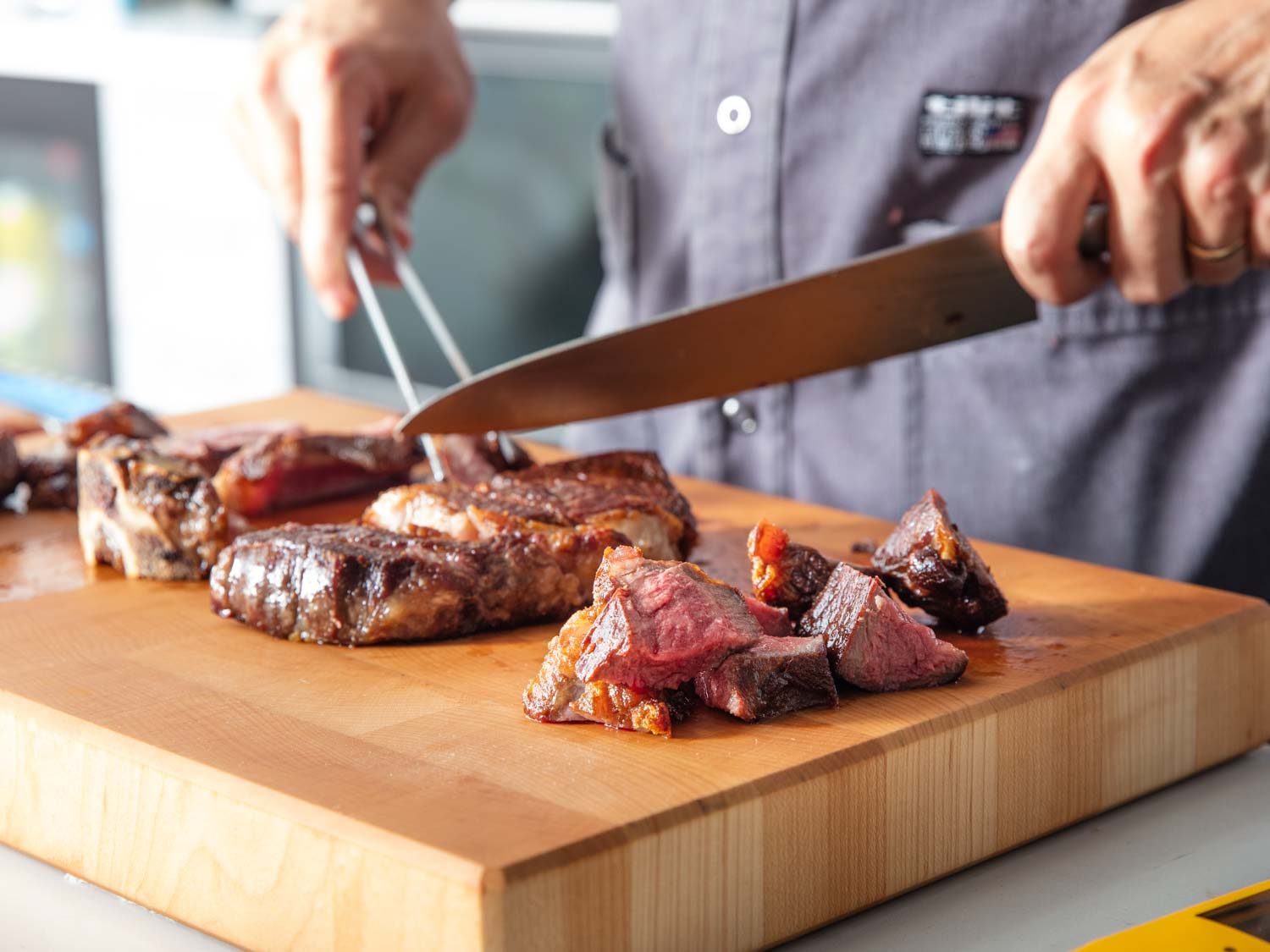
[Photographs: Vicky Wasik]
Imagine being told that more than a thousand dollars worth of beef was about to land in your lap—some of the world’s rarest and most sought-after steak, including the famed Japanese “Snow Beef” of Hokkaido and true wagyu from Kobe. Imagine your excitement while setting up a tasting to compare each against the others, all cooked in a variety of ways. Imagine getting so cocky you buy an aged prime ribeye steak for $40 from one of New York’s top butchers “just for kicks,” you know, to have something really average to measure against the greatness of the good stuff.
Now imagine eating all of that prized beef. Amazing, right?
Nope. It was awful. I mean, the beef wasn’t awful; the beef was stupendous. But not eaten like that, in one sitting. Not in those quantities.
There’s a video of our tasting, but we’re not going to show it to you because it’s too hard to watch. The effects of the beef hit us early and hard, right after the first round of steaks came off the plancha, with five more rounds still to go. Our energy levels dropped, our jokes became even more forced and less funny, our cheeks became flushed, and our bodies groaned under the oppressiveness of all that fat.
And this gets right to the most important lesson about indulging in real-deal, highest-quality, ultra-fatty Japanese wagyu: You can not, you should not, you must not eat a lot of it. We did it because we had to. No one should make the mistake of doing it voluntarily.
This isn’t a secret. Talk to any Japanese wagyu beef vendor who isn’t trying to upsell you and they’ll tell you the same thing: Each steak is meant to be shared by several people. Holy Grail Steak Company, the supplier who sent us these beef samples, put a warning right at the top of their email to us; we disregarded it in the interest of…science?
So why am I spending so much time hammering home this point if it’s commonly shared knowledge? Because I know there are other lunkheads out there, like me, who, despite being told that you should only portion about four bites per person, say to themselves, “Yeah, but I’m no ordinary person. I floss with sausages and stuff turduckens into pigs and then into cows, and that’s just my midmorning snack!” I’m trying to get through to those people, because these steaks are just too damned rich to eat more than a tiny bit.
That’s not all we learned though. Once the tallow in my veins cleared and my blood started to flow at a normal rate again, I was able to appreciate the steaks we’d tried. An enjoyable experience—even an extraordinary one—is possible, but only by following the guidelines below.
What Is Wagyu?
All but two of the six steaks in our tasting were some form of wagyu beef, two from Japan and two from American ranchers. Wagyu is a term that gets thrown around a lot, often in deceptive ways, so it’s important to be clear about it. In a nutshell, “wagyu” describes any of four Japanese breeds of cow: brown, polled, shorthorn, and black. While “wagyu” in and of itself doesn’t guarantee any specific quality level, the best wagyu is so richly marbled with intramuscular fat that it can play tricks with your eyes—is this meat threaded with fat or is it fat threaded with meat? This is what makes it so famous.
The most prized wagyu, called “A5,” comes exclusively from Japan. Adding to the confusion, there are also herds of wagyu in the United States; some are purebred but far more are some kind of cross, like wagyu bred with Angus. You can usually tell at a glance the difference between the very best Japanese wagyu and the very best American kind—not that one is objectively better than the other, only that the level of marbling is distinctly different.
Beyond that, there are additional names for wagyu that let you know where it comes from. “Kobe beef,” for example, describes wagyu that comes from the area around the Japanese city of Kobe; like wine appellations, the wagyu from the region must meet established criteria to earn the label. Another famed example of Japanese wagyu is the Snow Beef from Hokkaido. Both of these kinds were in our tasting.
Because the terminology can be confusing, and because true Japanese wagyu wasn’t available in the United States until 2012 (when a ban on Japanese beef was lifted), misuse of the terms and straight-up fraud is common. That Kobe beef slider you paid a premium to sample? Yeah, definitely not Kobe.
To learn more about the ins and outs of wagyu beef, read our article on the differences between real and fake wagyu.
How to Cook and Eat Wagyu Steak
So let’s say you want to experience what all the hubbub is about, and you’re ready to shell out for some good wagyu beef. What do you choose? And what do you do with it? Here’s what we learned from our tasting to help guide you through the process, and, hopefully, make sure you get a great experience for your money.
Meet the Steaks in Our Tasting
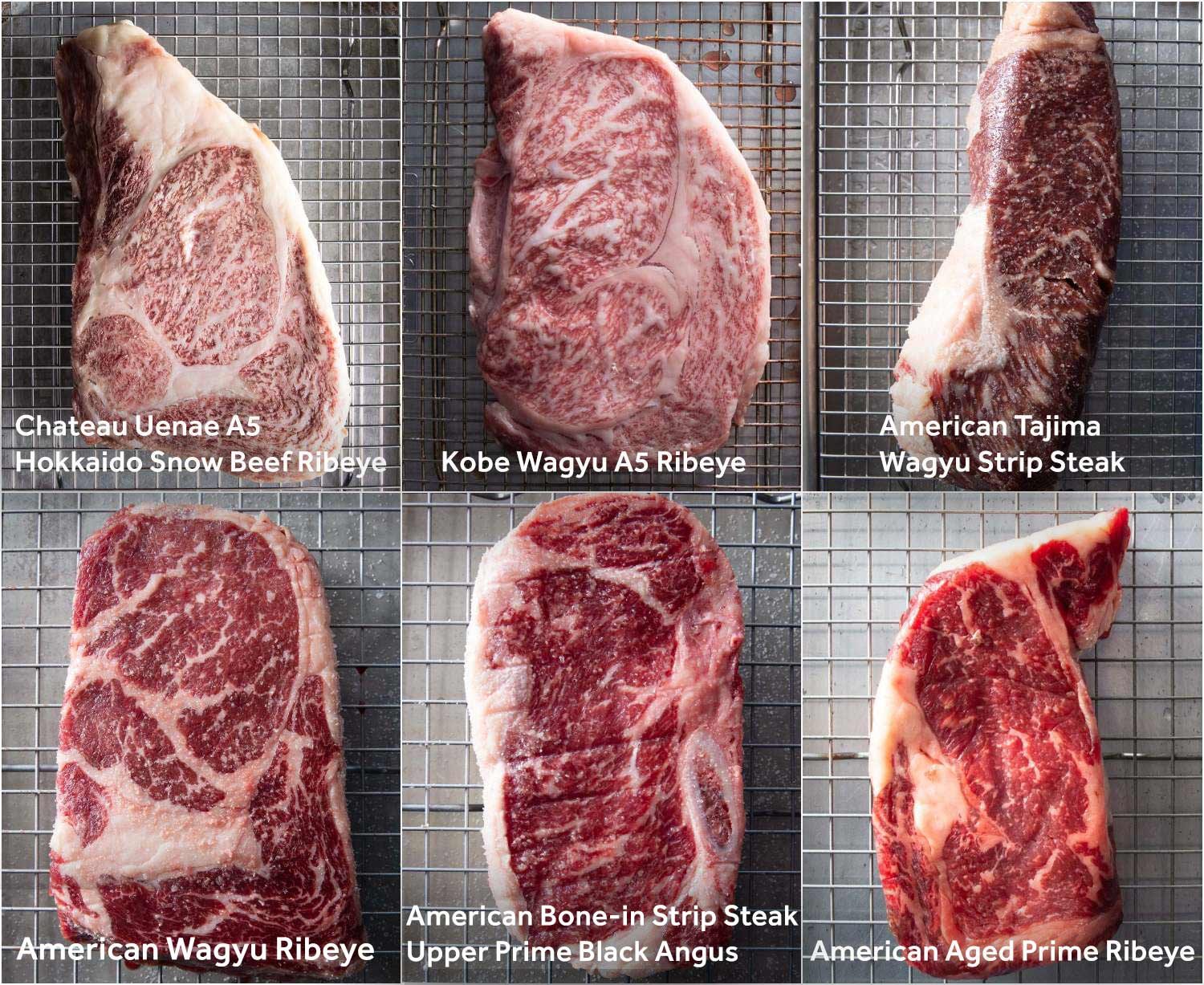
Five of the six steaks in our tasting were sent to us by Holy Grail Steak Company, an online purveyor of some of the best wagyu in the world. I added the sixth steak, an American dry-aged boneless ribeye, just as an additional point of comparison. Here’s the list:
- Kobe Wagyu A5 Ribeye: The one and only, real-deal Kobe beef. According to Holy Grail Steak Company, fewer than 1000 head of true Kobe cattle are exported from Japan annually, making this one of the rarest types of wagyu in the world. Just one roughly 14-ounce steak costs about $350.
- Chateau Uenae A5 Hokkaido Snow Beef Ribeye: Even rarer than Kobe, Hokkaido Snow Beef is produced by a single Japanese rancher, and only one or two cattle each month qualify for the farm’s highest “Snow Beef” designation. It’ll cost you about $350 to get about 13 ounces of this stuff.
- American Tajima Wagyu Ribeye: From American Tajima wagyu cattle (descended from the same famed black wagyu as Kobe) with some Angus mixed in, this boneless ribeye is about 16 ounces and costs about $70. It has great marbling by any standard except when put next to the Japanese examples above.
- American Tajima Wagyu Strip Steak: A 16-ounce strip steak from the same cattle as the American Tajima ribeye.
- American Upper-Prime Black Angus Bone-In Strip Steak: A bone-in strip steak from Black Angus cattle (not wagyu). “Upper-prime” signals that within the prime grade of beef, this beef has higher levels of marbling.
- American Prime Ribeye: This 30- to 60-day aged steak came not from Holy Grail Steak Company, but rather from Creekstone Farms, a Kansas-based Black Angus ranch.
While steaks can be cut to any number of thicknesses, the first thing we noticed with our samples, aside from very obvious differences of marbling between the Japanese and American examples, was the differing thickness of the steaks depending on their origin. The Japanese wagyu was cut much thinner, at about half an inch thick, while the American beef was cut into steaks that were between one and one-and-a-half inches thick.
This difference in thickness signals right away that the Japanese and American steaks are to be handled and eaten differently. With its abundant fat content, the Japanese wagyu overwhelms in larger portions (I think I made that clear above?), so the thinner steak makes it easier to portion into small bites, and to cook to a high doneness level.
Which Steak Should You Buy?
Despite struggling through our overambitious tasting, one thing was clear: You won’t go wrong with any of these steaks. That said, we did have some preferences. First, we’d steer (see what I did there?) you away from the strip steaks. It’s not that they’re bad, but they just don’t compare to the ribeyes, and if you’re going to go to the trouble of seeking out this premium beef experience, you might as well go all the way.
Choosing between Japanese A5 and American wagyu is more difficult question to answer. They’re completely different beasts. By far the most unique experience is the Japanese wagyu; it’s unlike any beef we’ve ever eaten before. That experience comes at a cost—these steaks are a serious investment.
The American wagyu steaks, on the other hand, are more familiar. They’re not nearly as fatty as the Japanese ones; instead, they eat much more like standard steaks, albeit very high-quality ones. And while they’re absolutely excellent, we were just as happy cutting into the aged prime ribeye I added to the tasting (to be honest, some of us maybe liked the deeper aged flavor of that one even more).
If you wanted to really splurge and set up a tasting, I’d maybe get one or both of the A5 Japanese options (the differences are subtle, but probably of interest to beef enthusiasts), one American wagyu to see what the breed is like outside of Japan, and then one aged prime American steak to compare that to. But if you’re going to do that, bring a lot of friends.
Cooking Methods
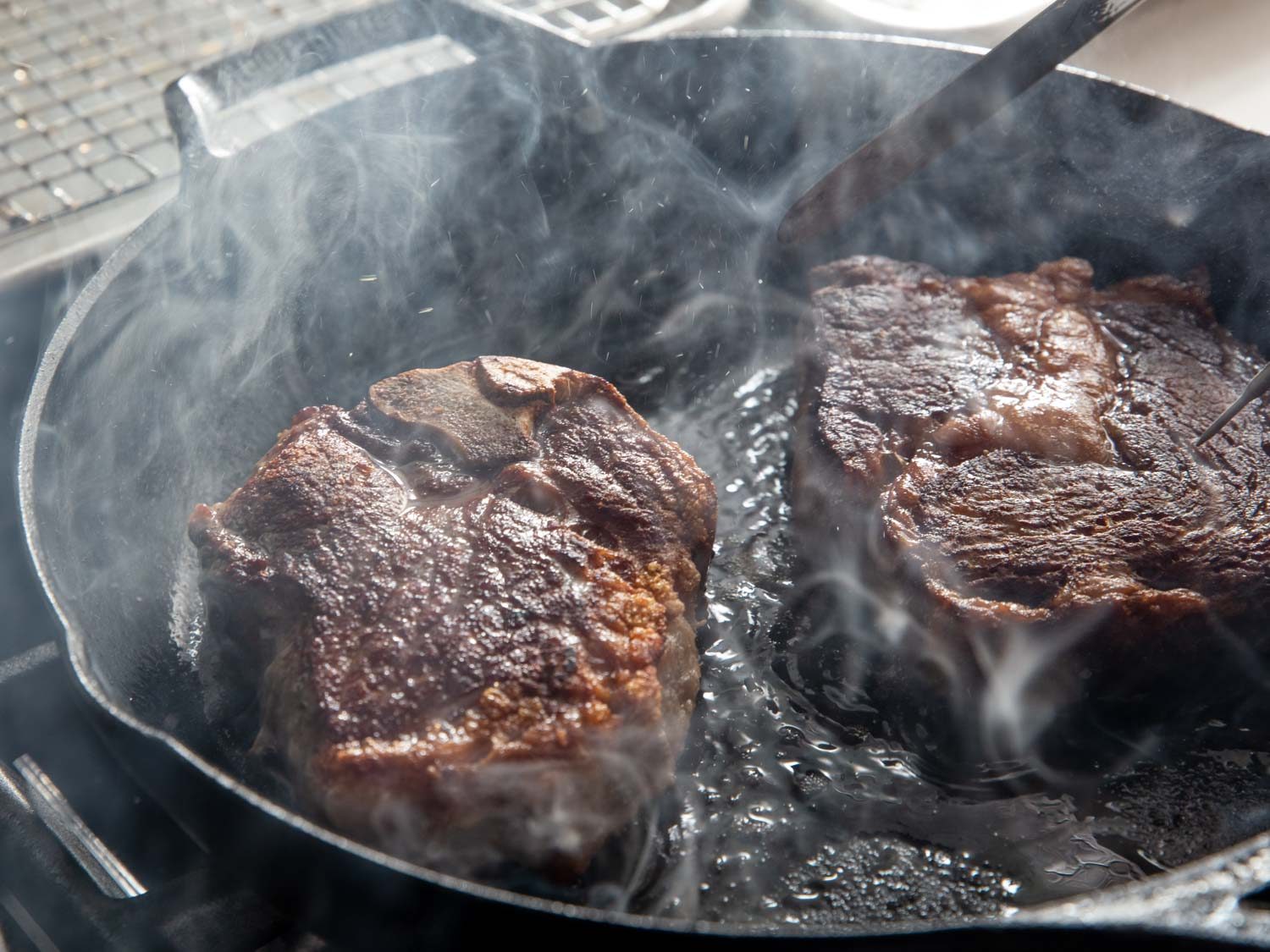
I cooked all the steaks three ways: On a ripping hot plancha set over a grill; in cast iron skillets; and directly over binchotan (Japanese charcoal) in a small hibachi.
The plancha I used was too hot, over-searing the exterior before the steaks had heated through. Because it was set over a gas grill burner and our particular plancha had small perforations in it, it also caused severe flareups, especially with the fattier Japanese beef. We didn’t care for the result, which was excessively charred and slightly bitter. Of course a plancha could be made to work given a different setup; the key is to regulate its heat so it doesn’t get too hot and prevents flareups.
The steaks seared in a cast iron pan all turned out well, regardless of the type. For the Japanese wagyu, it was easy to put a nice sear on it without over-roasting the meat, while all the other steaks cooked up beautifully as well.
I didn’t need to apply any special techniques for the cast-iron samples: no reverse sear, no sous vide. The Japanese steaks are too thin to warrant those treatments—once you have your sear, the steaks are done internally as well. For the thicker American ones, I had just as much success using the pan alone, simply flipping them back and forth until a great crust formed and they’d reached a nice medium-rare in the center. As I’ve written before, I often prefer my steaks pan-roasted like this from start to finish (though in this case I didn’t add any butter or aromatics because I wanted the steaks to stand on their own; you certainly could do a butter baste if you wanted).
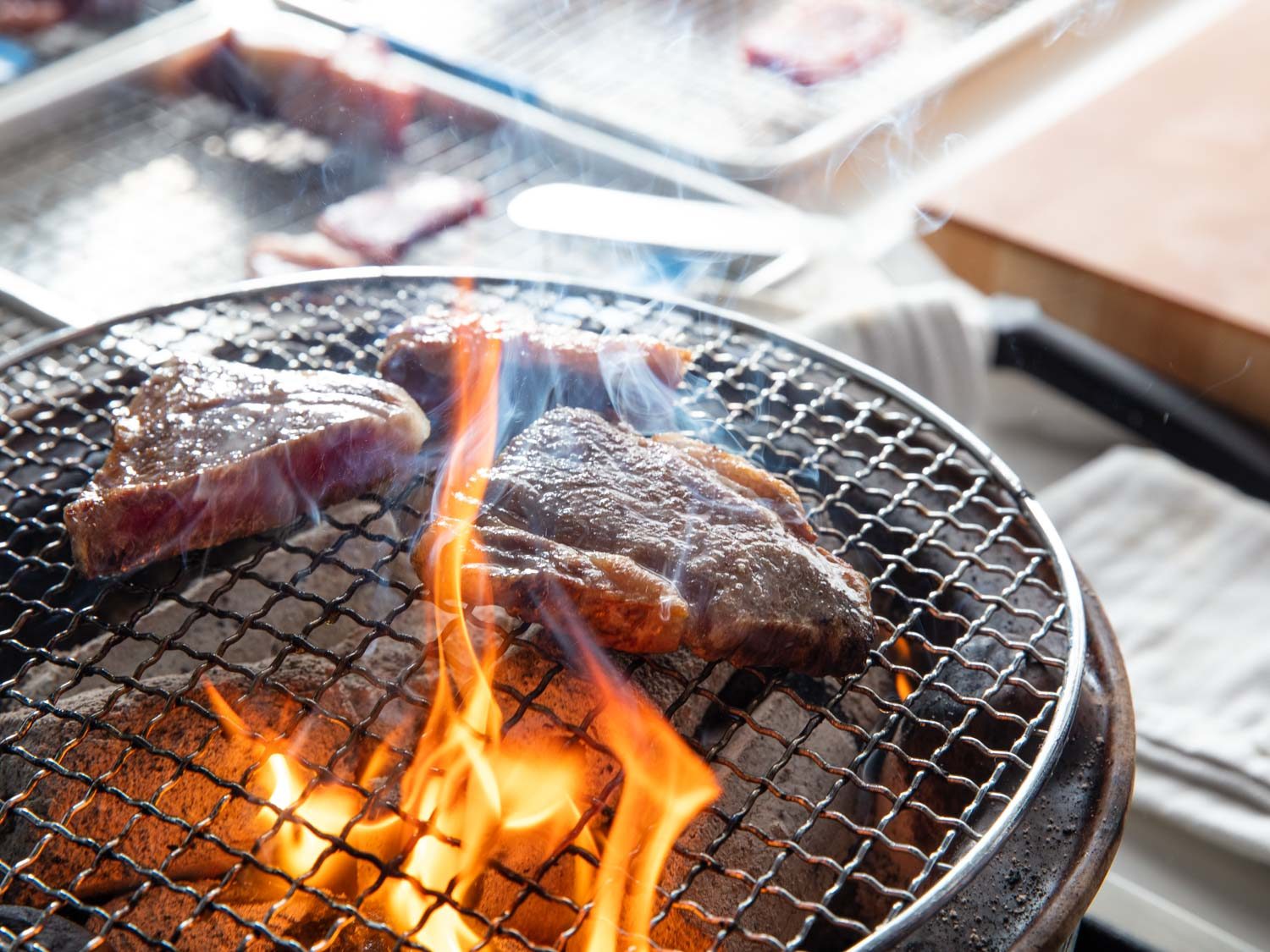
Holy Grail Steak Company doesn’t recommend grilling wagyu, especially the fattiest Japanese kinds, due to flareups. We found that when cut into small pieces before grilling, however, the Japanese wagyu came out great, with a delicious, very lightly charred flavor. Using binchotan and our small hibachi, which hovers the meat on a mesh wire grate very close to the coals, we were able to brown the pieces nicely before any major flareups happened (and when they did, we found it easy to move them out of the flames).
The American wagyu didn’t fare as well when prepared this way on the grill. Without the same marbling to internally baste it, it tended to overcook and grow chewy. That doesn’t mean you can’t grill those steaks, but you’d probably want to grill them whole so they remain tender and juicy within.
If there’s one big lesson we learned, it applies to the Japanese wagyu: don’t overthink it and don’t throw unnecessary technique at it. Because of how thinly the steaks are cut, you don’t need to use methods like the reverse sear or sous vide to strike the perfect balance between internal doneness and external sear. They come out best cooked simply in a skillet, or grilled very carefully over coals.
How Well-Done Should You Cook Wagyu Steaks
There’s no one right answer here, and as with any steak, no matter what one recommends, someone else will pop up to argue for a different level of doneness. To us, though, the Japanese wagyu was at its best cooked to about medium, while all the American steaks hit their peak around medium-rare, though medium was very good too.
The thinner cut of the Japanese steaks means they cook through more quickly, which, we think, is a good thing. Because of its abundant intramuscular fat, Japanese wagyu doesn’t easily dry out, and, if anything, needs a little more heat to begin melting that internal fat. It was hard to find a piece of the Japanese wagyu we didn’t like, once again thanks to that intramuscular fat: It’s an incredibly forgiving piece of meat that bastes itself and remains juicy no matter what. Medium-rare and below was harder to achieve with the Japanese cuts because of the thinness of the steaks—if you wanted any sear at all, the interior was going to heat up past those doneness levels.
The American steaks, both wagyu and Black Angus, eat much more like the steaks you’ve eaten at a classic American steakhouse or purchased from a butcher. The Japanese wagyu is a different story: It’s like a water balloon of liquid beef fat in your mouth, exploding as you chew it, and melting even more from the heat in your mouth. It’s more like foie gras—you want a small portion to savor, not a big slab of meat to eat with a side of potatoes.
How to Serve Wagyu Steak
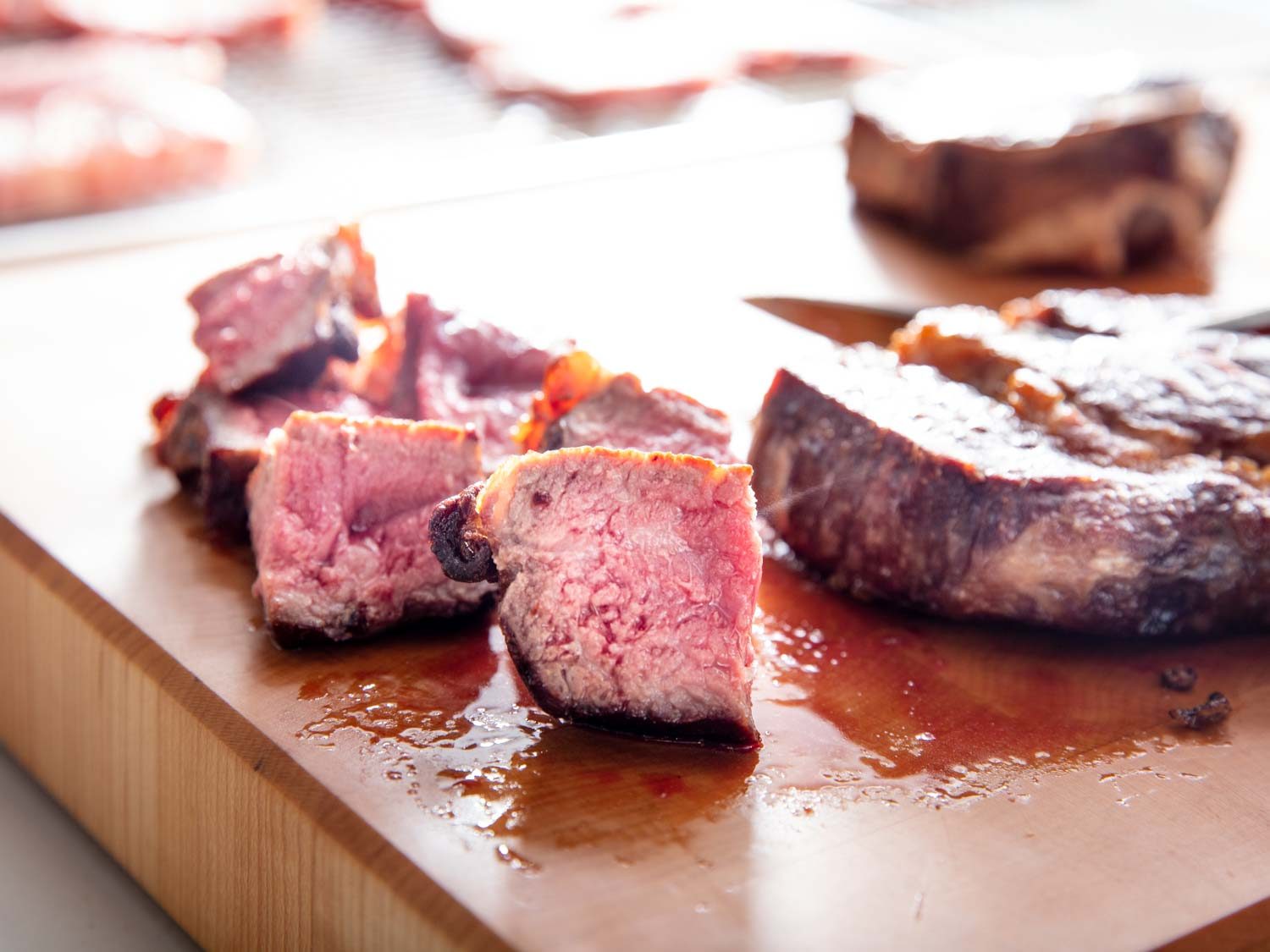
Very simply. Season the steaks with salt, maybe finish them with a little more salt afterwards; let the meat speak for itself.
For the Japanese A5 wagyu, plan to serve about one to two ounces of meat per person. That means a 13-ounce steak can feed anywhere from six to 12 people! If you’re interested in setting up a flight to compare the steaks, you’ll want more tasters present. As we found, it became increasingly difficult to appreciate the subtleties between the Kobe and Hokkaido Snow Beef because we were drowning in too much cow. If you don’t keep portions limited, you’ll find it similarly difficult to appreciate your investment.
If you don’t have that many tasters available, and if you can’t get smaller portions of A5 Japanese wagyu from your vendor, you’ll want to divide up your steaks into smaller pieces, only cooking a little at a time and keeping the rest frozen. Even if your wagyu arrives frozen, the good news is that its high fat content makes it easy to divide while still frozen, just like fatty pork. You may need to let it soften just a bit, but there’s no need to defrost it fully before cutting it into smaller pieces. Then tightly wrap or vacuum seal the pieces you won’t be cooking right away in individual portions, and save them for later.
The American wagyu and Black Angus steaks, on the other hand can each feed one to two people per 16-ounce portion. If you’re craving a big beefy meal, they’re the way to go. Seriously, don’t try to turn Japanese A5 wagyu into a steakhouse-style feast.
All products linked here have been independently selected by our editors. We may earn a commission on purchases, as described in our affiliate policy.